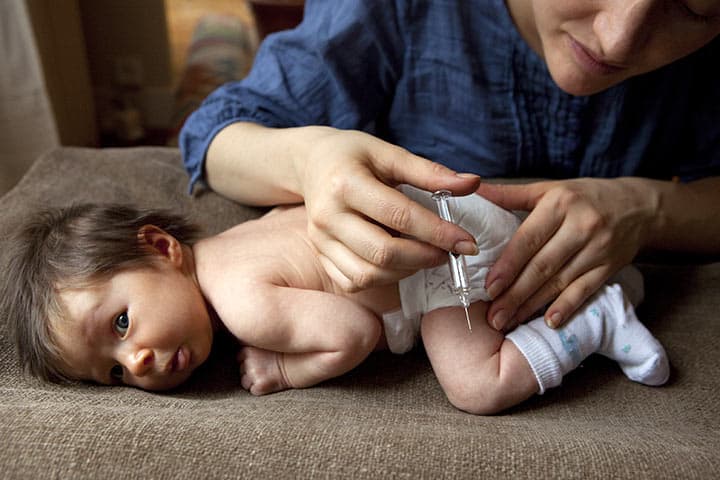When your little one suffers, you suffer along with her. That is what makes you a mother! Worrying comes with the territory. As does sleepless nights! Most mothers face these issues, but if you have a reflux baby, you just have to work a little harder.
Does your baby spit up a bit too much? Does she arch her back while feeding? Is she fussier than other babies her age? If you answered yes to these questions, your baby just might have reflux. A trip to the doctor will clarify your doubts and rule out GERD, reflux’ scarier cousin.
Both Reflux and GERD are common among infants and babies. Most babies outgrow their reflux by six months of age. And in the majority of cases, babies need no medication or treatment, just tons of laundry!
But in some cases, GERD can lead to Sandifer’s Syndrome.
What is Sandifer’s Syndrome?
Sandifer’s syndrome is a disorder of the upper gastrointestinal tract with neurological manifestations. It is seen in both young babies as well as adolescents. In scientific lingo, ‘Sandifer syndrome is a combination of GERD along with spastic torticollis and dystonic body movements with or without hiatal hernia’ (1). Though the cause is yet not clear, many experts suggest that the positioning of the body during an episode may provide relief from abdominal discomfort caused by acid reflux.
Sandifer Syndrome Symptoms :
The symptoms of Sandifer’s syndrome are often misinterpreted as seizure. If you notice any of the following symptoms, talk to your pediatrician:
-
- Arching of the back
- Sudden movement of the head and neck to one side, with the legs on the opposite side
- Gurgling sounds
- Abnormal eye movements
- Possible vomiting
Most Sandifer’s syndrome episodes last up to 1 to 3 minutes. In severe cases, these episodes can reoccur as many as ten times a day!
Here is a video that shows a classic Sandifer’s Syndrome episode:
Diagnosis of Sandifer’s Syndrome:
If you notice your little one showing the above symptoms, take her to the doctor.
- Your baby’s pediatrician will ask about your baby’s spasm history. Be ready for questions like ‘how many times a day does it occur?’ ‘What time of day?’ and ‘what leads to it?’ So, even before you head to the doctor, make a note of your baby’s seizure-like episodes. A little sleuthing on your part will make the doctor’s job easier.
- If the doctor is still unsure, he may order a video-EEG monitoring to diagnose your little one’s condition.
Sandifer Syndrome Treatment:
Though the symptoms of Sandifer syndrome might scare you, don’t panic! More often than not, your baby will require no treatment, unless her symptoms stem from a severe case of GERD. A bad GERD can hamper your baby’s eating and growth curve. Many GERD babies are diagnosed as ‘failure to thrive’ (lack of adequate growth). If that is the case, your pediatrician may recommend a few treatment options:
- Avoid overfeeding.
- Try increasing frequency and decreasing volume of feeds.
- Elevate your baby’s head while feeding her.
- Make sure to burp her for at least 20 minutes after each feed.
- Keep the baby in an upright position for 20-30 minutes after feeding.
When simple measures fail to reduce reflux, your doctor may advise you to:
- Provide Thickened Feeds: One great way of doing this is to mix rice cereal with your baby’s regular formula. Breast-fed infants can be given the thickener before their feed.
- Switching Formula: Your pediatrician may advise you to switch your baby’s formula. If your doctor suspects lactose intolerance, he may ask you to try a soy-based formula.
- Medication: In case none of the above-mentioned measures work, your doctor may try Infant Gaviscon®. In the case of severe GERD, Omeprazole may also be prescribed.
- Surgery: If nothing works and your baby shows no signs of improvement, surgery may be the only way out. But a surgery is only considered in extremely severe cases of GERD.
Sandifer’s syndrome in itself is no reason to worry. It is the underlying cause – GERD – that needs treatment. The symptoms of Sandifer’s syndrome are the body’s defense mechanism against the pain that comes with reflux and GERD.
If you are in the middle of a Sandifer’s syndrome episode – don’t panic! It will pass. And like most babies, your baby too will most likely outgrow it sooner than later. But talking to the doctor never hurts! So, book an appointment today.
Does your child have Sandifer’s Syndrome? What first alerted you to it? What symptoms did you child show? Share your experience with us in the comments section below.
























